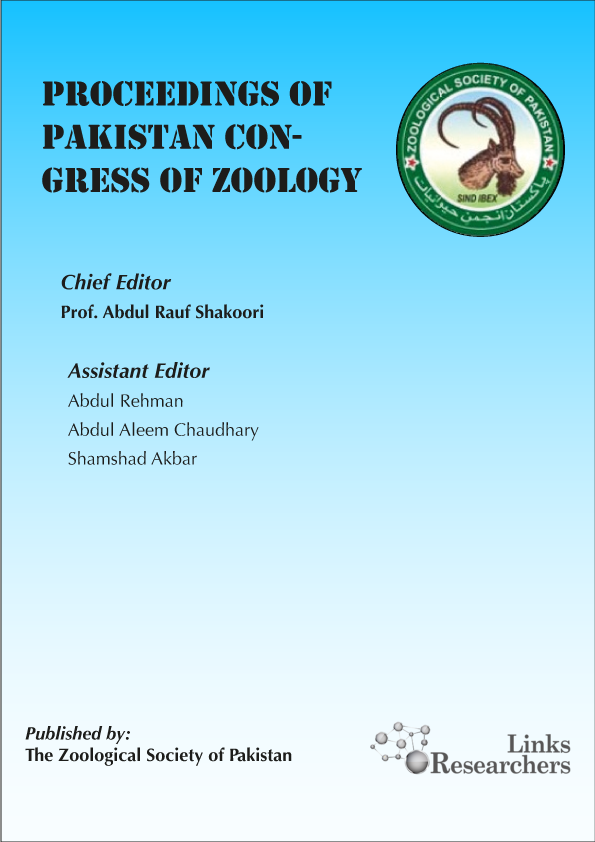Masood ur Rahman1*, Zahid Mahmood2, Taj Ali2, Muhammad Aziz Irfan Mufti3, Jehangir Khan Seyal4, Munir Ahmad5
E-mail | masoodra@hotmail.com
Muhammad Zahid1*, Muhammad Salman2, Shah Alam Khan2, Alamzeb1, Inamullah Khan1
Ghulam Ali Bajwa and Muhammad Arshad Khan
Muhammad Sohail1,*, Muhammad Naeem Khan1, Naureen Aziz Qureshi2 and Abdul Shakoor Chaudhry3
Zeenat Bano1,*, Sajid Abdullah1, Waqas Ahmad2, Muhammad Anjum Zia3 and Wardah Hassan1
Muhammad Naeem Safdar, Khalid Naseem, Muhammad Amjad, Amer Mumtaz and Saeeda Raza*
Azhar Usman Ali*, Ghulam Sarwar*, Muhammad Aftab* and Sher Muhammad**
Qaisar Jamal1,Salman Ahmad1, Nazma Habib Khan1, Sobia Wahid1, Muhammad Ikram2, Sadia Rehman2, Syed Basit Rasheed1 and Akram Shah1,*
Madeeha Arshad, Asmatullah, Chaman Ara
(sodium arsenate) other than general lethality additionally can be a teratogenic
agent. Present research work is focused on the teratogenic impacts of sodium
arsenate given to gravid mice (Mus musculus). Different doses of sodium arsenate
18.25, 37.5 and 75mg/kg B.W. were administered orally at day 6 of gestation
(single exposure group) to 15 fema...
Nighat Seema1*, Muhammad Hamayun1, Husan Ara1 and Raham Sheer Khan2
Asma Hassan*, Zuhair Hasnain, Shahzada Sohail Ijaz, Muhmmad Ansar, Muhmmad Rasheed, Ajaz Ahmad, Lubna Ayub Durani and Muhmmad Bilal Ali
Hafiz Abdullah Shakir1*, Javed Iqbal Qazi2, Abdul Shakoor Chaudhry2, Muhammad Irfan3, Muhammad Khan1, Shaukat Ali4 and Saima Shahzad Mirza5
H. Liu1, X.P. Tang1, R.J. Fang1,*, F.Yi2, C. Zhang2, R.Q. Yang1, F. Sun1 and S.Y. Zhou1
Jaffar Hussain1*, Syed Farman Ali Shah1, M. Zeenat Ali1 and Javad Ahmad Shah2
Farid Ullah Khan*
Hina Imtiaz1*, Salma Khalid2, Kashaf Riaz1, Muhammad Arshad Ullah3 and Zubair Rehman4
Zahid Hassan Tarar1, Muhammad Salik Ali Khan2*, Shahzada Munawar Mehdi3, Raza Salim4, Irfan Ahmad Saleem1, Saima Nazar5, Munir David2, Tahir Majeed6, Muhammad Sufyan Mughal7, Muhammad Saleem8, Umer Iqbal9, Muhammad Mazhar Iqbal10 and Muhammad Khalid Shaheen3
Malik Abdul Rehman1, Shafqat Ali1, Muhammad Babar Shahzad Afzal1, Muhammad Nawaz Khan1 and Mujahid Ali2*
Asim Faraz1*, Abdul Waheed1 and Nasir Ali Tauqir2
Hussein Saber Mohammaed Ali Al-Rashedy1* and Wadullah Asaad Abdullah Al-Mtewti2
Sanjeela Sabahat1*, Juliya Abbasi2, Mushtaq Ahmad1, Saima Mumtaz1, Taj Naseeb Khan1, Sudheer Tariq1 and Muhammad Imran1
Noha M. El-Shabrawy1, Atef M. Kamel2, Aza S. Goda1, Gehad R. Donia1, Ahmed M. Salah-Eldein2*
Noura El-Shahat Attia1*, Abd El-Khalek Ramadan El-Sheikh1, Mohamed Omia Siam2
Keywords | Dogs, Zn deficiency, Dermatosis, Skin affection
...Mohamed Saeed M. Hassan¹, Hitham Abdel-Saeed1*, Kawkab Abd El Aziz Ahmed2, Ossama Mohamed Abdou1
Laiba Shafique1*, Mahroze Fatima2, Syed Zakir Hussain Shah3, Muhammad Afzal4, Huma Naz5, Saif ur Rehman1 and Qingyou Liu1*
Alaa Jaheen*, Noha Salem, Mohamed El-sherif
Noor Muhammad Khan1,2, Tariq Mahmood Khalil1,3*, Rashid Rehan2 and Iftikhar Zeb4
Ghalib Ayaz Kachelo1, Nasir Ahmed Rajput1*, Muhammad Atiq1, Shahbaz Talib Sahi1, Nasir Ahmad Khan1, Akhtar Hameed2, Noor Muhammad1 and Muhammad Saqib Mushtaq1
Hasnain Raza1*, Tanveer-ul-Haq1, Muhammad Imran1, Nabeel Ahmad Ikram2 and Muhammad Bilal Shoukat1
Emtiaz Ibrahim Ghoniem, Gaber Mamdouh Abdelgalil, Amira Farouk Gad* and El-Sayed Hassan Eshra
Adrial Adrial1*, Rudy Priyanto2, Salundik Salundik2, Ahmad Yani2, Luki Abdullah3
A. M. Korayem1†, M. M. M. Mohamed1 and S. M. El-Ashry2
Khasan Khamidovich Shakhbiev1*, Saidkhamzat Saidmagomedovich Abumuslimov1, Larisa. Vakhaevna Taramova1, Islam Khasanovich Shakhbiev1, Svetlana Aleksandrovna Shemyakova2
Ghulam Sarwar Shah1,2, Maqsood Anwar Rustamani1, Rab Dino Khuhro1, Rehana Naz Syed1 and Abdul Mubeen Lodhi1
Walaa I. Mohameden1, Haidy G. Abdel-Rahman2, Ibrahim M. Hegab3*
Roheela Yasmeen1,3* , Faheem Hafeez1 , Umme Ammara1 , Rubab Younas1 , Sibtain Ahmad2 , Zulfiqar Ali3, Zaheer Ahmad Nasir4
Pramudya Andiana*, Moch. Geerhan Miraja Syahdan, Khothibul Umam Al Awwaly, Abdul Manab
Mansoor Ali Khan*, Khalid Imran, Zahid Rauf, Tanvir Hussain, Muhammad Umair Khan and Sajid Ali
More than 66.6% members of Schizophyllaceae are recorded from the broad-leaved trees, with 23.8% from conifers and the remaining 9.6% from unidentified hosts distributed in the Himalayan tract of NWFP (27.8%), Punjab (42.6%), AJK (4.5%) and Sindh (24.8%). The majority (71.4%) members of this family are collected after the monsoon, while the re...
Aysha Fatima1, Safdar Ali1, Saira Azmat2, Luqman Amrao1, Muhammad Usman Ghani3*, Yasir Iftikhar4, Muhammad Ahmad Zeshan4*, Adeel Ahmad5 and Humaira Kalsoom6
Mohamed T. A. Soliman1, Hadeer M. Shosha2, Hala M. Ebaid2, Heba Nageh Gad El-Hak2, Heba M.A. Abdelrazek3*
Sherine Abbas1, Hadeer M. Shosha2, Hala M. Ebaid2, Heba Nageh Gad El-Hak2, Heba M. A. Abdelrazek3*
Soumble Zulfiqar* and Abdul Rauf Shakoori
Abd-Elhalim, B.T.1*; Gamal, R.F.1; Abou-Taleb, Kh.A.1; Haroun, A.A.2
Abdul, K. Madadi1*; Hadia Rauf1; Mohammad, H. Falahzadah1; Ahsanullah Yousufzai1; Abdul, S. Jamily1; Wakil, A. Sarhadi2
Amany A. Hassabo1; Basant A. Ali1; Shaimaa A. Tawfik2; Hossam E. Emam3*
















